Sourdough Bread Recipe
This basic Sourdough Bread Recipe produces an artisan loaf with a crisp crust and chewy crumb. It is best baked in a Dutch oven, but the recipe is very flexible and adaptable.
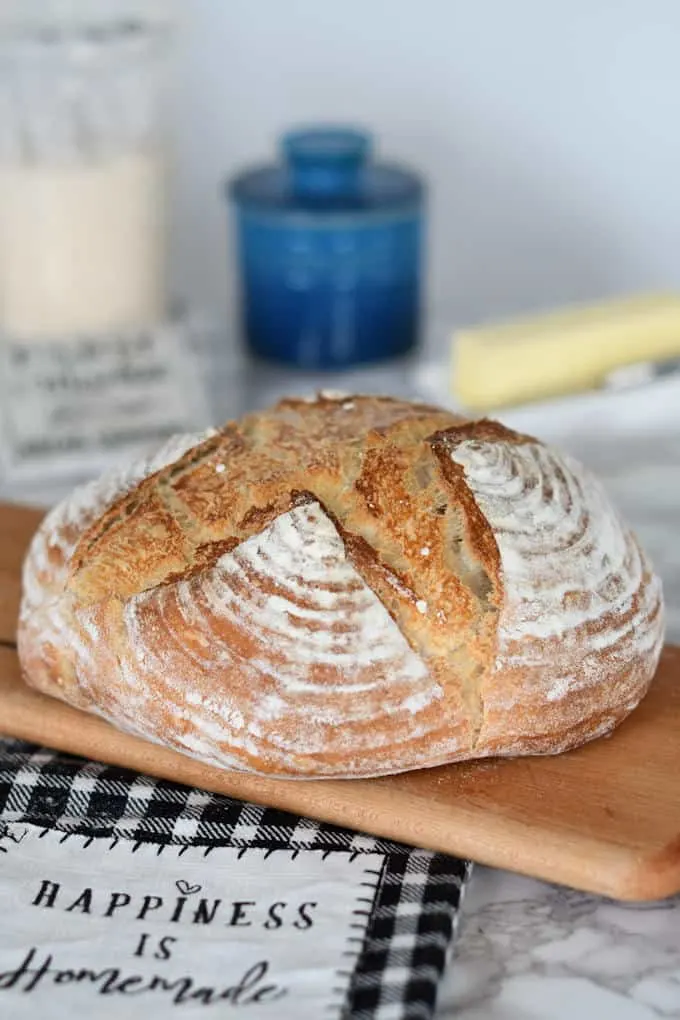
I think that this recipe for crusty sourdough bread is reason enough for making a sourdough starter. The wild yeast in sourdough starter makes an exceptionally delicious loaf of bread.
Because the bread freezes really well, I make a loaf of this Sourdough Bread each time I need to feed my sourdough starter.
What is Sourdough Bread?
Any bread that you make with a sourdough starter is a “sourdough” bread. There are a few key steps that will produce a light, crusty and chewy bread that is the quintessential loaf we all imagine when we hear “artisan sourdough bread ” .
What does the “hydration” percent mean for sourdough starter?
Hydration percent means the ratio of water to flour used for feeding your starter. If you feed your starter with equal weights of flour and water then your starter is 100% hydration. If you feed your starter with twice as much flour as water the hydration level is 50%.
Ingredients
- Active sourdough starter (100% hydration)
- Warm water
- Unbleached all purpose flour
- Salt
How to make Sourdough Bread
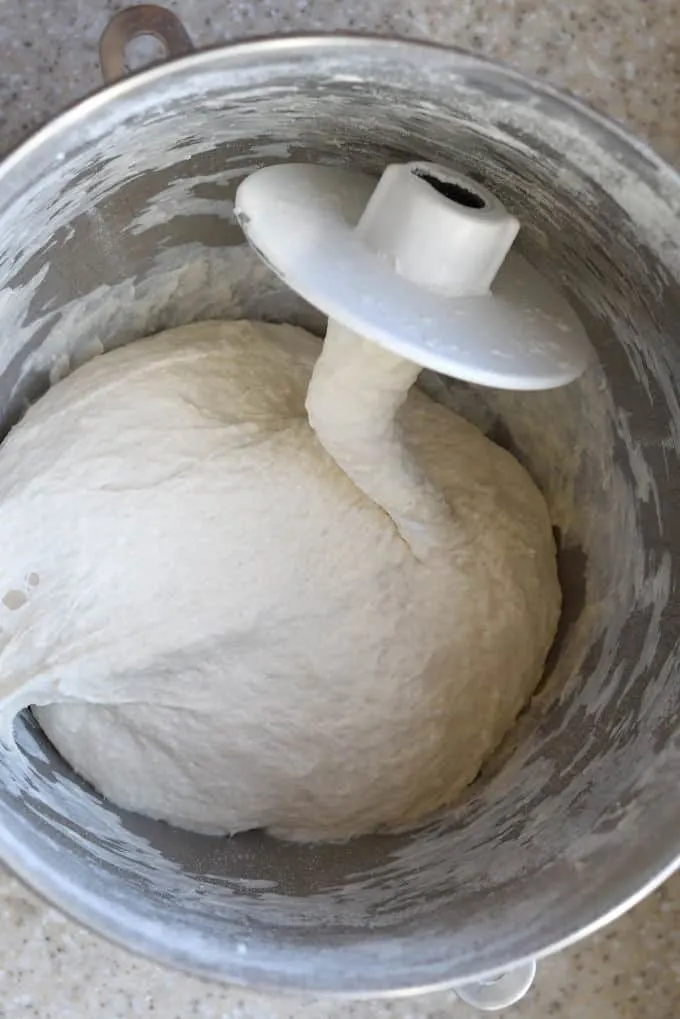
- The dough can be mixed by hand or on a stand mixer.
- The dough starts our quite sticky but will become more cohesive as it ferments.
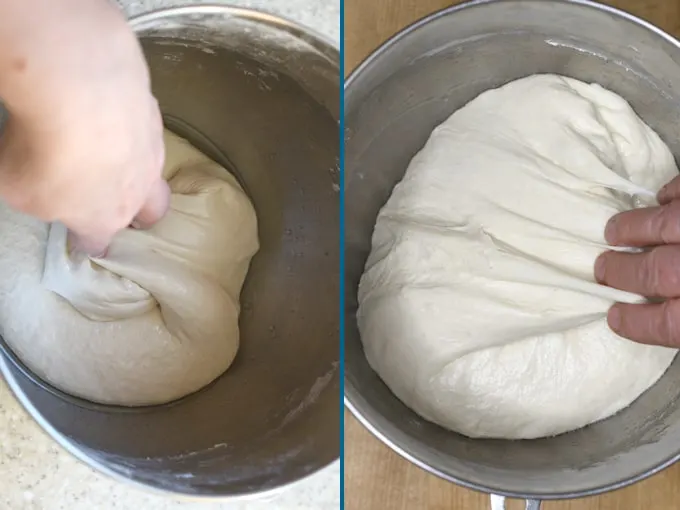
- Stretch and fold the dough several times during the initial fermentation.
- The dough will become more lively and aerated as it ferments.
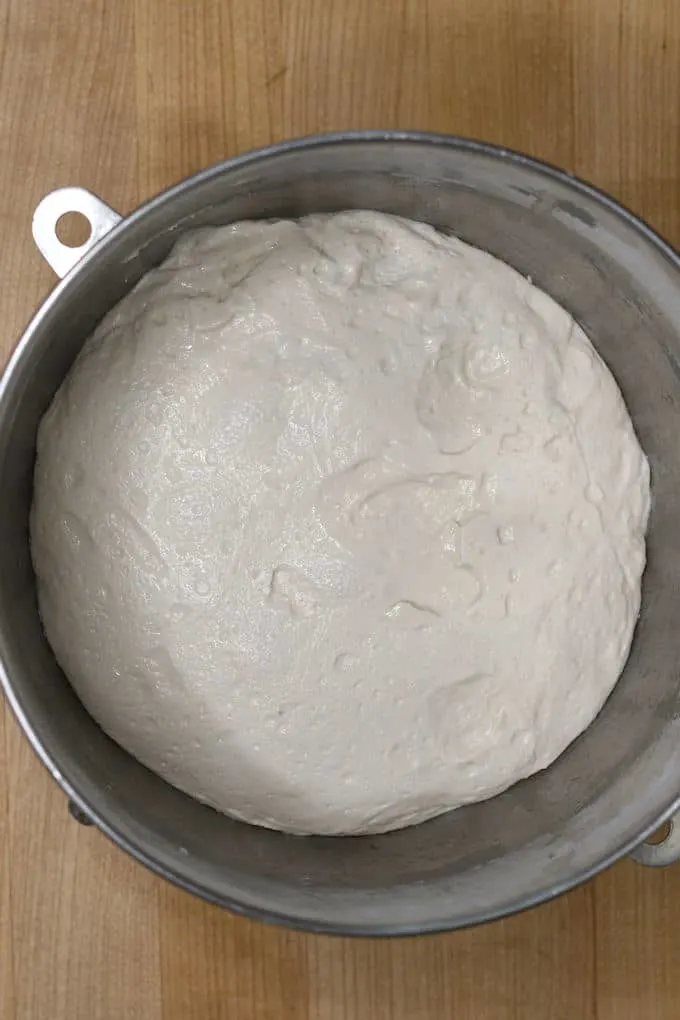
- Refrigerate the dough overnight. The dough can be refrigerated for up to 2 days.
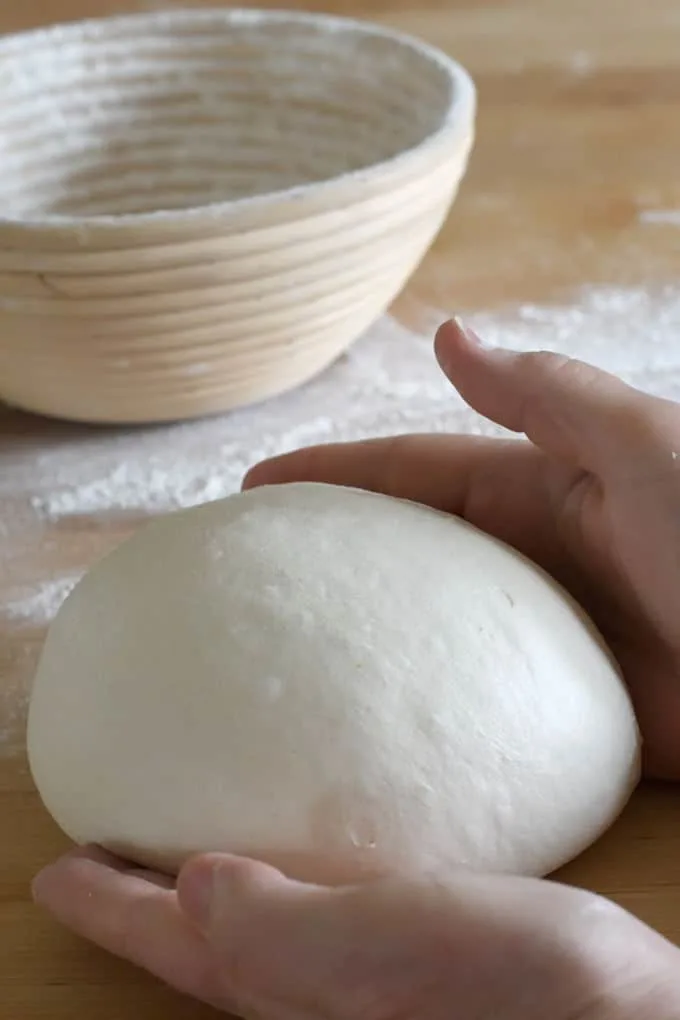
- Turn the dough out onto a lightly floured surface.
- Use cupped hands to form the dough into a smooth ball.
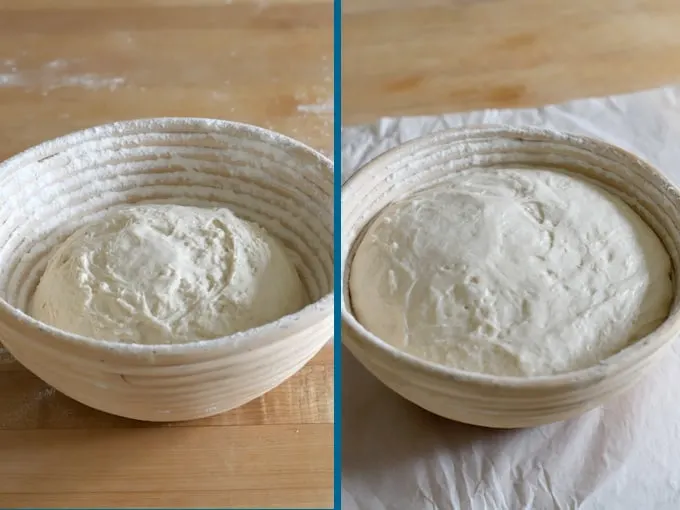
- Set the dough aside to rise for 2-3 hours until it doubles in size. The exact rise time will depend on the temperature of the dough and the ambient temperature.
- If you don’t have a proofing basket you can put the dough directly onto a piece of parchment paper for rising.
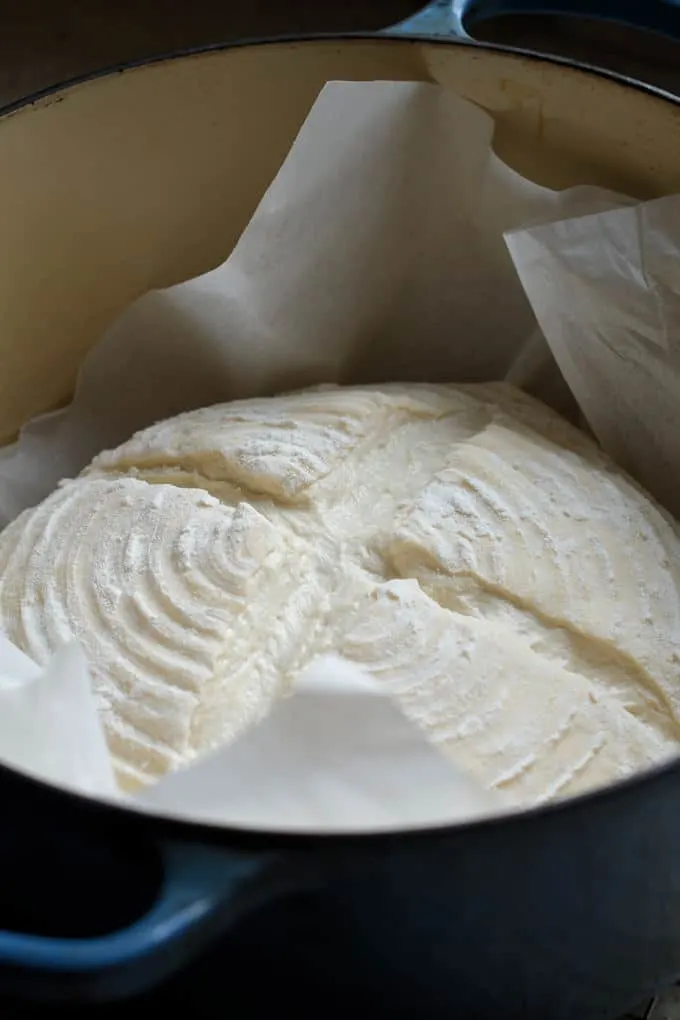
- Flip the loaf onto a piece of parchment paper, score the top, then use the paper to lower the loaf into the preheated Dutch oven.
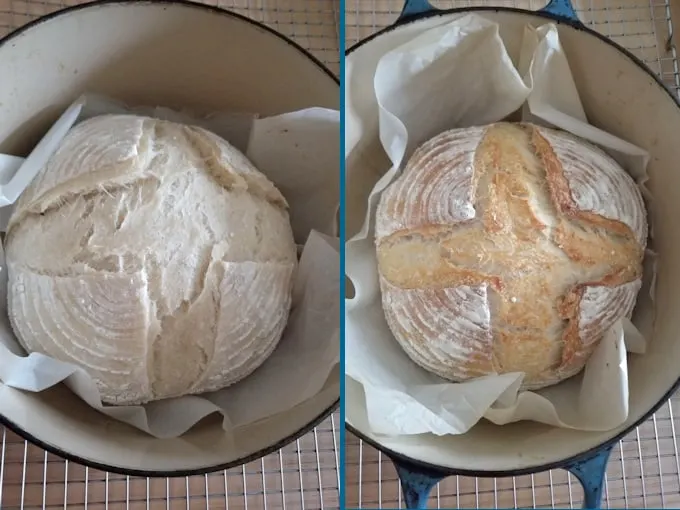
- After 20 minutes baking the loaf is well-risen but still pale.
- Remove the lid and continue baking another 20 minutes until the loaf is golden brown.
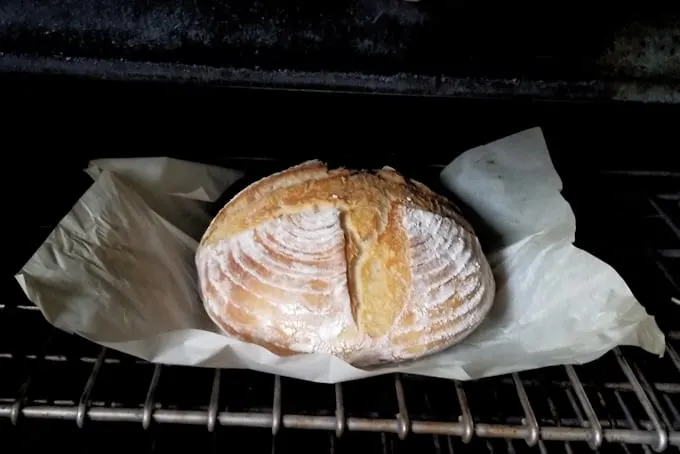
- Remove the loaf from the Dutch oven.
- If the crust is not quite brown enough you can return the loaf to the oven to finish baking until deeply golden brown and very crisp.
Timeline for making sourdough bread:
- If your starter needs feeding, do that the night before or early in the morning of the day you want to make the dough.
- Mix the dough in the afternoon. Allow it to ferment at room temperature all day and refrigerate the dough in the evening before going to bed.
- The dough can stay in the refrigerator for 2-3 days at this point.
- Take the dough out first thing in the morning and shape the loaf.
- Leave the loaf at room temperature to rise for 1 1/2- 2 hours.
- You should have fresh bread by lunch time.
Pastry Chef tips for making artisan Sourdough Bread at home
- A wet dough is a sticky dough and can be a bit fussy to handle. Because this bread has a long, slow fermentation, the bread has time to develop plenty of gluten without lots of kneading.
- The more lively and active your starter is, the better loaf you’ll produce. Use your starter after it’s been fed and just before it’s reached it’s peak rise.
- If you are working with a starter that is not 100% hydration you’ll need to adjust the amount of flour/water in the dough to allow for the difference.
- The Dutch oven creates a moist environment that develops that thick, crispy crust on the bread. Any oven-safe, heavy pot with a lid will work if you don’t have a Dutch oven.
FAQs for making sourdough bread at home:
Yes, start the dough early in the morning and skip the refrigeration step.
You can proof the dough right on the parchment paper that will go into the Dutch Oven.
Use any heavy, oven-safe pot with a lid, or slide the parchment onto a sheet pan to bake. The crust might not be quite as crisp as it is when baked in a Dutch oven.
You could try and shape this dough into a baguette. But I suggest you try this recipe for Sourdough Baguettes instead.
The bread keeps for 2-3 days at room temperature.
Yes! Store the loaf or slices in a freezer bag for up to 3 months.
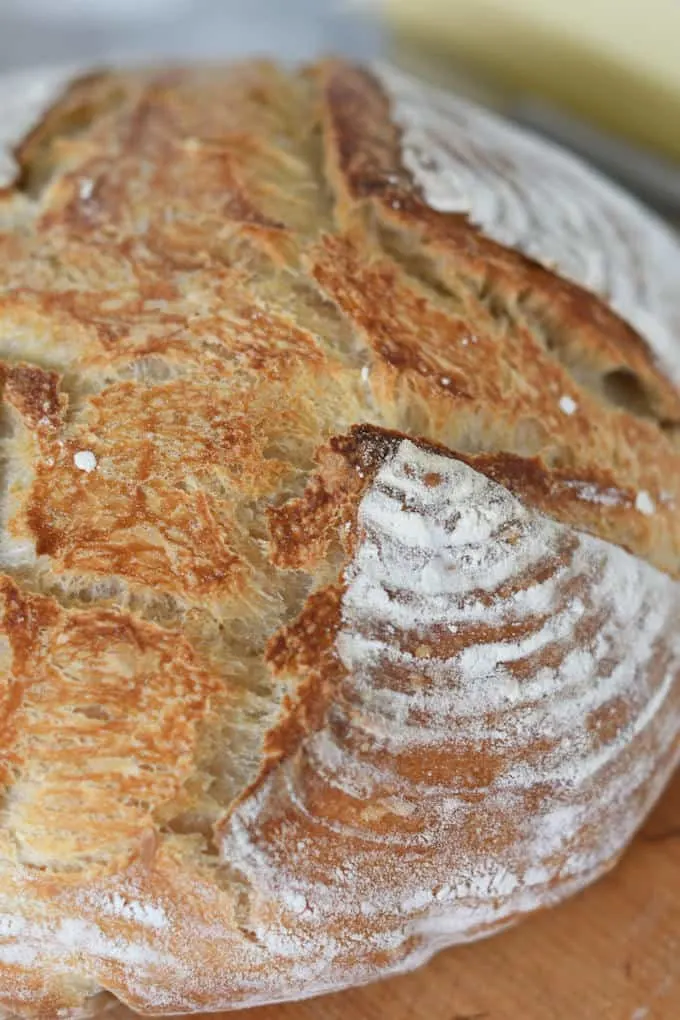
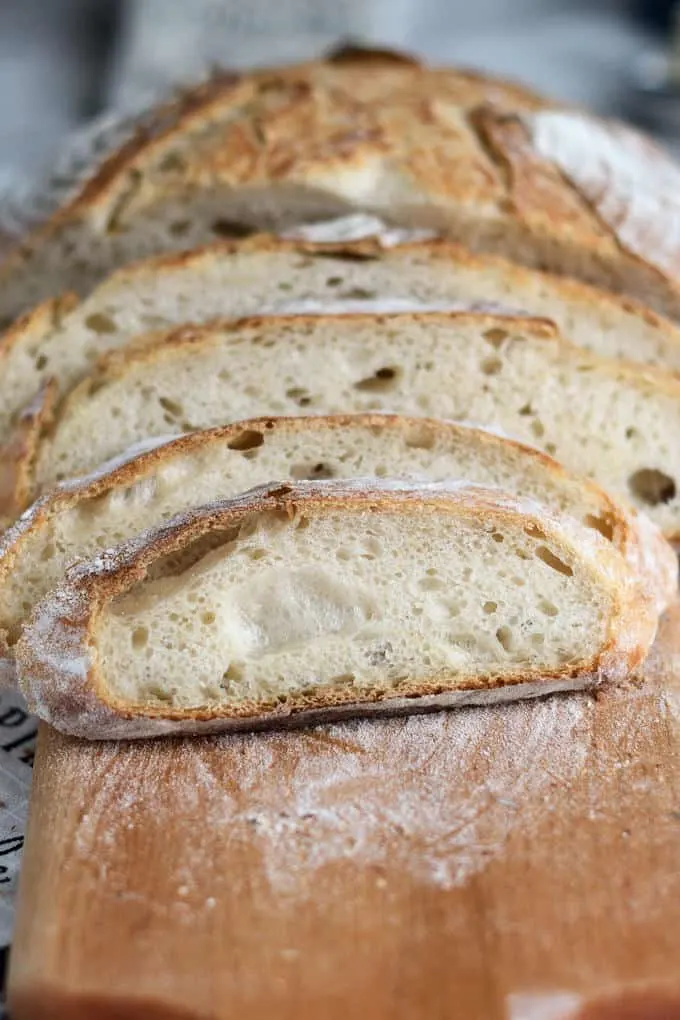
I know you hate to throw away that sourdough discard. Check out these recipes that use sourdough discard.
If you want to make a loaf with the crispiest crust ever, try making Sourdough Semolina Bread.
If you love this recipe as much as I do, I’d really appreciate a star rating and a quick comment. Ratings and comments help my recipes show in search results. Thanks!
Artisan Sourdough Bread Recipe
Ingredients
- 8 ounces active sourdough starter (1 cup (100% hydration))
- 8 ounces warm water (1 cup)
- 12 ½ ounces unbleached all purpose flour (2 ½ cups, see note)
- 1 ½ teaspoons table salt
- Rice flour for proofing basket
Instructions
- Combine 8 ounces active sourdough starter, 8 ounces warm water and 1 ½ cups (7 ½ oz) of the flour. Mix with the paddle on low speed until it forms a thick batter. Cover the bowl and set aside for 30-60 minutes.
- If using a stand mixer, change to the dough hook. Add 1 ½ teaspoons table salt and the rest of the flour and mix until the dough begins to form a ball around the hook. If mixing by hand add the flour using a wooden spoon and/or a plastic bowl scraper. This dough is quite sticky.
- Place the dough into a lightly oiled bowl, turn once to coat the dough. Cover the bowl and set it aside at room temperature.
- After 60 minutes uncover the bowl, lift one side of the dough and fold it into the middle of the dough. Repeat with the other three sides of the dough then flip the dough over. You're basically turning the dough inside-out to redistribute the yeast. Cover the bowl and every hour or so repeat the procedure.
- After about 2 hours the dough should be lively, elastic and airy. If the dough is still sluggish give it another hour or two at room temperature. Cover tightly and refrigerate overnight.
- Remove the dough from the refrigerator and dump it onto floured surface. Without kneading, use your cupped hands to form the dough into a smooth ball. Cover lightly with a kitchen towel or plastic wrap and let the dough rest for 20-30 minutes. If the ball flattens during the 20 minutes fold it onto itself and form the ball again. This step will help you check if your dough is elastic enough to help it’s shape during the final rise and baking.
- Uncover the dough and knead 1-2 times. Reshape the dough into a smooth ball and place the dough into a well-floured proofing basket (I use a mix of ½ rice flour and ½ all purpose flour in the basket) or directly onto a sheet of parchment paper.
- Cover the dough and leave in a warm place until it's almost doubled in size and it springs back slowly when poked, about 2 hours depending on the room temperature and dough temperature. Meanwhile, preheat the oven to 425°F. Place a Dutch oven with a lid into the oven to preheat.
- If the loaf is in a proofing basket, place a sheet of parchment over the dough and gently flip it over. Use a single edge razor or very sharp knife to cut a ¼" deep X across the top of the loaf. Remove the preheated pan from the oven and remove the lid. Use the parchment to lift the loaf into the Dutch oven.
- Replace the lid on the pot and slide it into the oven. Bake for 20 minutes. Remove the lid from the Dutch oven. The loaf should be well risen and pale in color.
- Continue baking another 20 minutes until the loaf is nicely browned and beginning to crisp. Remove the pan from the oven. Use the parchment to lift the loaf out of the pan. Use the parchment to place the loaf directly onto the rack in the oven. Bake another 5-10 minutes until the loaf is deeply browned and very crisp. Total baking time is about 40-50 minutes.
- Cool completely on a wire rack before slicing.
Would you like to save this recipe?
As an Amazon Associate and member of other affiliate programs, I earn from qualifying purchases.


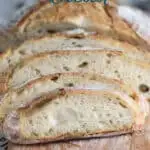
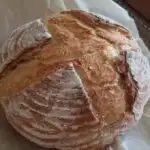





Would this recipe with adding King Arthur pizza dough flavoring and pizza flavoring? I want to try an inclusion loaf.
Is the pizza flavoring a spice mix? I don’t see any reason you couldn’t add a spice mix.
Yes, it is a spice mix. Thank you!
This is my first sourdough loaf attempt, and it turned out great! Your instructions were amazing.
I’m trying this recipe for my first time.
My starter was feed this morning and used at its peak.
I also noted, as did another commenter, that when I did the add in of the second amount of flour (1 cup) and mixed it in it did not form a ball but a very shaggy mess. I mixed it fully and dumped it into my lightly oiled bowl hoping for the best. I know the stretch & fold does help build firmness.
I’m also wondering what you consider “room temp”? My house is at 68° F. I have generally put my mixtures into my oven, with the light, on to create a warmer space. I’d that too warm. It gets quite warm in there which really surprised me.
Hi Cathy, My kitchen is quite cool at this time of year. I have a few ways of keeping my sourdough warm enough. I will sometimes turn on the oven just long enough for the heating element to come on, then turn it off. It warms to maybe 75-80F and it’s perfect for keeping the dough. The dough will should become more cohesive during the fermentation and from the folding. If you look at the first process photo in the post you’ll see that the dough in the bowl with the hook is quite sticky. Do you have a thermometer in your oven to track the temp with the light on? Maybe you can toggle the light on and off if you think it’s getting too warm.
Love this recipe, it’s definitely my go to! Thank you!
Eileen, I have a few questions on your Sourdough Bread Recipe.
I have made it, perhaps, 10-12 times and always get a delicious loaf of bread. This week, after refeeding my starter, I made another loaf and had the following questions about the process.
I have noticed that when doing the second mix that the dough begins to form a ball on the dough hook but before the flour has been incorporated, and once the flour is, the dough is not a ball on the dough hook, but a puddle in the bottom of the mixer bowl. I need to use a spatula to move it to the lightly oiled bowl as well as turning the dough to coat it.
The dough seems to firm up, somewhat, when I stretch and fold it, but it never looked like your photos. It was very loose and didn’t have any structure to speak of. It was not holding it’s shape when forming it into a ball prior to placing in the proofing basket. The final loaf looked flat although it was dense with a nice flavor.
I am asking this because I followed up this loaf with my first Semolina Sourdough Bread recipe and had a quite different experience. The dough was so much more dense and easier to work with.
I’m wondering if the additional ¼ cup of flour could be the answer. I know that the semolina flour probably adsorb water differently than All Purpose. Is that what could make the difference?
Thank you for all your fantastic recipes. I haven’t found a 4 star one yet. They all seem to be 5 stars to me.
Hi David, are you saying you’ve always had this experience with this recipe, or just this time? The semolina flour is higher in protein and will absorb more water than the ap flour in this recipe. Are you weighing your ingredients? If you are using cup measurements be sure to use the “dip and sweep” method for filling the measuring cup. Read more about measuring baking ingredients here. Is your starter 100% hydration and fully active when you mix the dough? Are you using unbleached AP flour? You can make this recipe using bread flour for a tighter dough if that is easier for you to work with.
Eileen, I do measure out everything. I use King Arthur Unbleached AP flour in the red bag. I have to say that it happens pretty much every time, but this last time it was more noticeable, especially after I had the experience with the Semolina Sourdough recipe.
My starter is 100% hydrated. I weigh out the starter, flour and the water (4oz. each), so I’m going to assume that is what you mean by 100% hydrated. I started back at the beginning several years ago watching the starter grow in the container and waiting till it dropped back to it’s previous level, but grew to understand that I needed to use it right after it reaches it’s peak, and that is the condition I it was in for this latest loaf.
I assume that it could be that the room temperature was a little cooler than normal.
I just discovered that my KitchenAid range has a Bread Proofing setting that I think is 100 degrees. I would think that is a little to warm. Your thoughts.
Please understand that the bread comes out delicious. I’m just wondering if it’s me or the conditions I proof it or something else and I hope this might be helpful for some other beginning bakers.
Thanks for your comments.
Proofing at 100F is fine, especially for the final proof. Yes, I get the best results when I use my starter just as it has peaked. Are you putting the dough into the fridge overnight? I find the chilled dough easy to shape.
Yes, I put the dough in the refrigerator over night and that does seem to help, but still too loose to be able to hold. It’s a quick transfer from bowl floured surface, forming into ball, repeat then again a quick transfer into the banneton to proof. I’m able to use the lame to cut 1/4″ cuts in the surface before baking.
The bread looks good, although a little less rise than I would hope, and tastes great.
I think i’ll try the Bread Proofing setting on the range next time.
Thanks again for your comments.